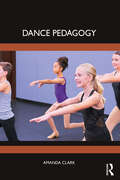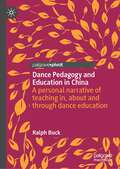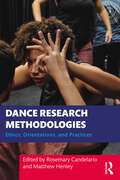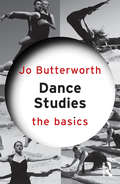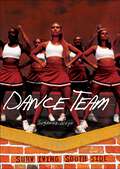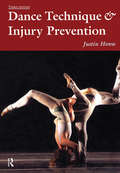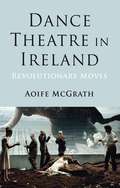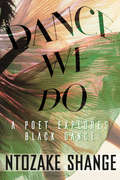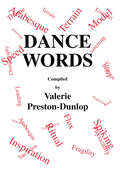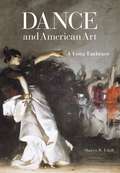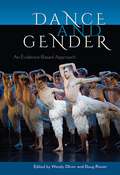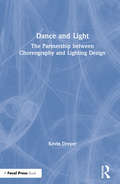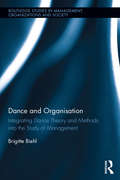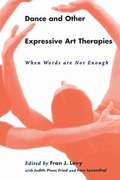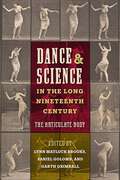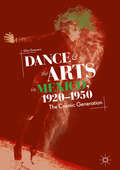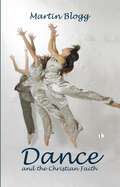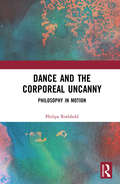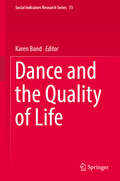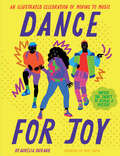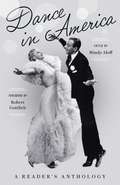- Table View
- List View
Dance Pedagogy
by Amanda ClarkDance Pedagogy is a comprehensive resource designed for dance students and teaching artists to develop skills and strategies in the multifaceted practice of teaching dance.This invaluable resource features essential components and considerations necessary for the dance teacher in any setting, including the private and community sector, university setting, and professional venues. Five distinct units provide insight into the paradigm, learning process, class environment factors, planning, and delivery of the dance class in a broad context through the use of examples within the dance forms of ballet, jazz, modern, tap, and hip-hop. Readers intently explore cognitive and motor learning, strategies for developing curricula and lesson plans, and methods of delivering material to students. Basic principles of anatomy, understanding student behavior and participation, the importance of diversity, equity, inclusion and accessibility (IDEA), music concepts for the dancer, injury prevention, and classroom management are included to provide a well-rounded approach to the many challenges faced in the classroom.Dance Pedagogy provides the most holistic approach available in the art of teaching dance and is a core textbook for academic courses related to Dance Teaching Methods as well as an invaluable handbook for practicing dance teachers.
Dance Pedagogy and Education in China: A personal narrative of teaching in, about and through dance education
by Ralph BuckThis pivot offers an innovative approach to dance education, bringing a creative and inclusive dance education pedagogy into Chinese dance classrooms. Associate Professor Ralph Buck’s experiences of teaching dance at the Beijing Dance Academy and the possible implications for dance education in China lie at the heart of this text. Through a critical examination of personal teaching practice, pedagogical issues, trends and rationales for dance education in the curriculum are highlighted. Informed by constructivist ideals that recognise dialogue and interaction, this pivot suggests that dance can be re-positioned and valued within educational contexts when pedagogical strategies and objectives are framed in terms of teaching and learning in, about and through dance education.
Dance Practices as Research: Approaches to the Safeguarding and Transmission of the Intangible Cultural Heritage of Dance (Heritage Studies)
by Vicky KämpfeThis book contributes to the growing scientific literature on ‘intangible cultural heritage’ – determined by UNESCO to be particularly worthy of safeguarding and transmission – by advancing a theoretical-analytical framework for the (in)tangible cultural heritage of dance. By exploring the potential of the ‘intangible materiality’ of dance practice the book argues that implementing the concept of a ‘performative dance-archive’ creates a new analytic field: research in praxis. The concept of the ‘performative dance-archive’ draws out the potential for safeguarding and transmission of dance heritage, but also the challenges of the opposition between living heritage and the codifying of cultural inventories. This book uses the formal and contextual transformation of Argentine tango and German modern dance to discuss this ambiguity of intangible heritage and how the “performative dance-archive” creates a cognitive, empractical approach to determine, archive, and distribute dance knowledge. This is a timely methodological intervention in the context of the increasing importance of the intangible cultural heritage. It enables us to re-revise the concept of (im)materiality and the specific knowledges within cultural practice as a necessary fundamental category for research-processes and societal growth. This book is directed both to researchers in the field of intangible cultural heritage and to practitioners and researchers searching for new ways of investigating methods and perspectives to understand 'immaterial materialities'.
Dance Production: Design and Technology
by Jeromy HopgoodDance Production: Design and Technology introduces you to the skills you need to plan, design, and execute the technical aspects of a dance production. While it may not seem that staging a dance production is that different from a play or musical, in reality a dance performance offers up unique intricacies and challenges all its own, from scenery that accommodates choreography, to lighting design that sculpts the body, and costumes that complement movement. This unique book approaches the process of staging a dance production from a balanced perspective, making it an essential resource for dancers and designers alike. Covering a broad range of topics, author Jeromy Hopgood takes the reader through the process of producing dance from start to finish – including pre-production planning (collaboration, production process, personnel, performance spaces), design disciplines (lighting, sound, scenery, costumes, projections), stage management, and more. Bridging the gap between theatrical and dance design, the book includes a quick reference guide for theatrical and dance terminology, useful in giving dancers and designers a common working vocabulary that will ensure productive communication across the different fields.
Dance Production: Design and Technology
by Jeromy HopgoodDance Production: Design and Technology, Second Edition is an introduction to the skills needed to plan, design, and execute the technical aspects of a dance production.Covering a broad range of topics, author Jeromy Hopgood takes the reader through the process of producing dance from start to finish. Part I addresses the collaborative process, business and organizational concerns for dance companies, planning the production, and the relationship between dance and performance spaces/staging methods. In Part II, each unique production area is examined, including production and stage management, sound, costume and makeup, scenery and props, lighting, and projection/video design. Each design area is divided into two chapters – the first introducing key concepts, and the second focusing on the process of creating the design. Part III brings back the popular quick reference guides from the first edition, providing an expanded and revised tool to bridge the language gap between the worlds of theatrical production and dance, and ensure productive communication across the different fields. This second edition features updated information on technology and processes, two new chapters on touring and non-traditional productions, more information on arts management within dance production, a comprehensive look at dance and video (including remote/streaming performances, as well as dance film), and additional chapter projects throughout the book.This unique book approaches the process of staging a dance production from a balanced perspective, making it an essential resource for choreographers, theatre designers, dancers, and management personnel alike, including for use in Dance and Dance Production courses.
Dance Research Methodologies: Ethics, Orientations, and Practices
by Rosemary CandelarioDance Research Methodologies: Ethics, Orientations, and Practices captures the breadth of methodological approaches to research in dance in the fine arts, the humanities, the social sciences, and the natural sciences by bringing together researchers from around the world writing about a variety of dance forms and practices. This book makes explicit the implicit skills and experiences at work in the research processes by detailing the ethics, orientations, and practices fundamental to being a researcher across the disciplines of dance. Collating together approaches from key subdisciplines, this book brings together perspectives on dance practice, dance studies, dance education, dance science, as well as dance research in cross-, multi-, and interdisciplinary fields. Practice-based chapters cover methodological approaches that provide rich examples of how research design and implementation are navigated by practicing scholars. Dance Research Methodologies also includes a practical workbook that helps readers to decide upon, refine, and enact their research, as well as develop ways in which to communicate their process and outcomes. This vital textbook is a valuable resource for research faculty interested in interdisciplinary conversation and practice, emerging scholars honing their methodological approaches, graduate students engaged in research-based coursework and projects, and advanced undergraduates.
Dance Studies: The Basics (The Basics)
by Jo ButterworthA concise introduction to the study of dance ranging from the practical aspects such as technique and choreography to more theoretical considerations such as aesthetic appreciation and the place of dance in different cultures. This book answers questions such as: Exactly how do we define dance? What kinds of people dance and what kind of training is necessary? How are dances made? What do we know about dance history? Featuring a glossary, chronology of dance history and list of useful websites, this book is the ideal starting point for anyone interested in the study of dance.
Dance Team (Surviving Southside)
by Charnan SimonIzzy's the newest member of the Southside High dance team. And she may have picked a bad time to join up. The team's captain, Camilla, is determined to win regionals by any means necessary. When the dance team discovers that Izzy is best friends with the leader of a rival squad, the pressure's on. Will Izzy injure her old friend to sabotage Southside's competition?
Dance Technique and Injury Prevention (Ballet, Dance, Opera And Music Ser.)
by Justin Howse Shirley HancockDance Technique and Injury Prevention has established itself as the key reference for everyone involved in dance injury and treatment, physical therapy, and dance instruction.
Dance Theatre in Ireland
by Aoife McgrathDance theatre has become a site of transformation in the Irish performance landscape. This book conducts a socio-political and cultural reading of dance theatre practice in Ireland from Yeats' dance plays at the start of the 20th century to Celtic-Tiger-era works of Fabulous Beast Dance Theatre and CoisC#65533;im Dance Theatre at the start of the 21st.
Dance We Do: A Poet Explores Black Dance
by Ntozake ShangeIn her first posthumous work, the revered poet crafts a personal history of Black dance and captures the careers of legendary dancers along with her own rhythmic beginnings.Many learned of Ntozake Shange's ability to blend movement with words when her acclaimed choreopoem for colored girls who have considered suicide/when the rainbow is enuf made its way to Broadway in 1976, eventually winning an Obie Award the following year. But before she found fame as a writer, poet, performer, dancer, and storyteller, she was an untrained student who found her footing in others' classrooms. Dance We Do is a tribute to those who taught her and her passion for rhythm, movement, and dance.After 20 years of research, writing, and devotion, Ntozake Shange tells her history of Black dance through a series of portraits of the dancers who trained her, moved with her, and inspired her to share the power of the Black body with her audience. Shange celebrates and honors the contributions of the often unrecognized pioneers who continued the path Katherine Dunham paved through the twentieth century. Dance We Do features a stunning photo insert along with personal interviews with Mickey Davidson, Halifu Osumare, Camille Brown, and Dianne McIntyre. In what is now one of her final works, Ntozake Shange welcomes the reader into the world she loved best.
Dance Words (Choreography and Dance Studies Series #Vol. 8.)
by Valerie Preston-DunlopFirst Published in 1995. Routledge is an imprint of Taylor & Francis, an informa company.
Dance and American Art
by Sharyn Rohlfsen UdallFrom ballet to burlesque, from the frontier jig to the jitterbug, Americans have always loved watching dance, whether in grand ballrooms, on Mississippi riverboats, or in the streets. Dance and American Art is an innovative look at the elusive, evocative nature of dance and the American visual artists who captured it through their paintings, sculpture, photography, and prints from the early nineteenth century through the mid-twentieth century. The scores of artists discussed include many icons of American art: Winslow Homer, George Caleb Bingham, Mary Cassatt, James McNeill Whistler, Alexander Calder, Joseph Cornell, Edward Steichen, David Smith, and others. Â Â Â As a subject for visual artists, dance has given new meaning to America’s perennial myths, cherished identities, and most powerful dreams. Their portrayals of dance and dancers, from the anonymous to the famous—Anna Pavlova, Isadora Duncan, Loïe Fuller, Josephine Baker, Martha Graham—have testified to the enduring importance of spatial organization, physical pattern, and rhythmic motion in creating aesthetic form. Â Â Â Through extensive research, sparkling prose, and beautiful color reproductions, art historian Sharyn R. Udall draws attention to the ways that artists’ portrayals of dance have defined the visual character of the modern world and have embodied culturally specific ideas about order and meaning, about the human body, and about the diverse fusions that comprise American culture.
Dance and Cultural Difference in Aotearoa: Finding Common Ground in Rural Dance Studio Education (Critical Studies in Dance Leadership and Inclusion)
by Kristie MortimerThis book provides a critical reflection on the ways dance studio teachers recognize, reflect and respond to cultural difference within their dance studio classes, particularly in the rural context in Aotearoa/New Zealand. Through dance teachers’ narratives, it reveals the complexities of multiculturalism within dance studio classes and examines related issues of inclusion and exclusion within dance education.Understanding the dance practices provided by teachers like those in rural communities within Aotearoa/New Zealand is an increasingly urgent concern in an era of growing political, social and cultural tensions, for students and scholars of performing arts, leadership and community development. While previous research and publications have investigated cultural difference and global multicultural arts practices, this book presents a critical lens on performing arts practice and socio-cultural challenges experienced by local dance teachers within rural communities in Aotearoa/New Zealand.
Dance and Gender: An Evidence-Based Approach
by Wendy Oliver and Doug RisnerDriven by exacting methods and hard data, this volume reveals gender dynamics within the dance world in the twenty-first century. It provides concrete evidence about how gender impacts the daily lives of dancers, choreographers, directors, educators, and students through surveys, interviews, analyses of data from institutional sources, and action research studies. Dancers, dance artists, and dance scholars from the United States, Australia, and Canada discuss equity in three areas: concert dance, the studio, and higher education. The chapters provide evidence of bias, stereotyping, and other behaviors that are often invisible to those involved, as well as to audiences. The contributors answer incisive questions about the role of gender in various aspects of the field, including physical expression and body image, classroom experiences and pedagogy, and performance and funding opportunities. The findings reveal how inequitable practices combined with societal pressures can create environments that hinder health, happiness, and success. At the same time, they highlight the individuals working to eliminate discrimination and open up new possibilities for expression and achievement in studios, choreography, performance venues, and institutions of higher education. The dance community can strive to eliminate discrimination, but first it must understand the status quo for gender in the dance world. Wendy Oliver, professor of dance at Providence College, is coeditor of Jazz Dance: A History of the Roots and Branches. Doug Risner, professor of dance at Wayne State University, is coeditor of Hybrid Lives of Teaching Artists in Dance and Theatre Arts: A Critical Reader. Contributors: Gareth Belling | Karen Bond | Carolyn Hebert | Eliza Larson | Pamela S. Musil | Wendy Oliver | Katherine Polasek | Doug Risner | Emily Roper | Karen Schupp | Jan Van Dyke
Dance and Light: The Partnership Between Choreography and Lighting Design
by Kevin DreyerDance and Light examines the interconnected relationship between movement and design, the fluid partnership that exists between the two disciplines, and the approaches that designers can take to enhance dance performances through lighting design. The book demystifies lighting for the dancer and helps designers understand how the dancer/choreographer thinks about their art form, providing insight into the choreographer’s process and exploring how designers can make the most of their resources. The author shares anecdotes and ideas from an almost 50-year career as a lighting designer, along with practical examples and insights from colleagues, and stresses the importance of clear communication between designers, choreographers, and dancers. Attention is also given to the choreographer who wants to learn what light can do to help enhance their work on stage. Written in short, stand-alone chapters that allow readers to quickly navigate to areas of interest, Dance and Light is a valuable resource for lighting design classes wishing to add a section on dance lighting, as well as for choreography classes who want to better equip young artists for a significant collaborative partnership.
Dance and Organization: Integrating Dance Theory and Methods into the Study of Management (Routledge Studies in Management, Organizations and Society)
by Brigitte BiehlDance and Organisation is the first comprehensive work to integrate dance theory and methods into the study of management, which have developed an interest in the arts and the humanities. Dance represents dynamics and change and puts the moving body at the centre, which has been ignored and oppressed by traditional management theory. ‘Being’ a leader however also means to ‘move’ like one, and critical lessons can be learned from ballerinas and modern dancers. Leadership is a dialogue, as in the work of musicians, conductors and DJs who manage groups without words. Movement in organisational space, in a museum or a techno club can be understood as a choreography and site-specific performance. Movement also is practically used for leadership and employee development workshops and can be deployed as an organisational research method. By taking a firm interdisciplinary stance in dance studies and organisational research to explore management topics, reflecting on practitioner accounts and research projects, the book seeks to make an innovative contribution to our understanding of the moving body, generating new insights on teamwork, leadership, gender in management, organisational space, training and research methods. It comprises an important contribution to the organizational behaviour and critical management studies disciplines, and looks to push the boundaries of the academic literature.
Dance and Other Expressive Art Therapies: When Words are Not Enough
by Fran J. Levy<p>The field of dance/movement therapy has long awaited a book, such as this one, which gives us detailed clinical material on specific patient populations. Fran Levy's first book, Dance/Movement Therapy: A Healing Art, provided a strong practical, historical, and theoretical foundation on which this book firmly stands. All of the selections that follow have been written by recognized leaders and contributors to the field. <p>Expressed in language that appeals to the heart as well as the mind, the book addresses immediate and pressing clinical concerns. Technical jargon is kept to a minimum, and, when used, is always defined. Throughout the book, the needs of patients are carefully considered and creatively met through the courage and perseverance of each therapist. Thoughtful and sensitive descriptions of the individuals discussed allows for an unusual intimacy between the reader and the patient. The authors believe that the experience of movement, on both symbolic and expressive levels, can transform individuals and guide their journeys to recovery.</p>
Dance and Science in the Long Nineteenth Century: The Articulate Body
by Lynn Matluck Brooks Sariel Golomb Garth GrimballRevealing the interplay and influence of dance and science during an age of colonial expansion Bringing together dance and science, two paradigms that explore the nature and possibilities of the body, this volume illuminates the meanings and articulations of dance in nineteenth-century societies. This global collection of studies reveals how the two fields informed each other’s development and engaged with dominant European worldviews in a time of unprecedented colonial expansion. The chapters in Dance and Science in the Long Nineteenth Century examine how trends and developments in the performing arts reflected scientific thinking of this era, including the categorization of “types” of bodies and the ranking of cultural and religious beliefs, as well as how dance served as an active site of inquiry where the workings and limits of the human body could be studied. Researchers discuss topics including the influence of plant biology on the aesthetics of ballet, technological advancements in the staging and recording of performances, arguments for the use of Eurhythmics in promoting a stronger “race,” and European fascination with Indian dance and yoga. Featuring response essays that put leading scholars in conversation with one another and offer new perspectives, this volume is unique in its geographic scope and its discussion of diverse bodies, cultures, themes, and scientific disciplines. It sheds light on a historical interplay that has shaped many of today’s political and cultural realities.Contributors: Johanna Pitetti-Heil | Chantal Frankenbach | Jane Desmond | Christian Ducomb | Claudia Jeschke | Kélina Gotman | Pallabi Chakravorty | Andrea Harris | Dick McCaw | Stephen Ha | Emily Coates | Tiziana Leucci | Elizabeth Claire | Susan Cook | Carrie Streeter | Olivia Sabee | Janice Ross | Alexander H. Schwan | Whitney Laemmli
Dance and the Arts in Mexico, 1920-1950: The Cosmic Generation
by Ellie GuerreroDance and the Arts in Mexico, 1920–1950 tells the story of the arts explosion that launched at the end of the Mexican revolution, when composers, choreographers, and muralists had produced state-sponsored works in wide public spaces. The book assesses how the “cosmic generation” in Mexico connected the nation-body and the dancer’s body in artistic movements between 1920 and 1950. It first discusses the role of dance in particular, the convergences of composers and visual artists in dance productions, and the allegorical relationship between the dancer's body and the nation-body in state-sponsored performances. The arts were of critical import in times of political and social transition, and the dynamic between the dancer’s body and the national body shifted as the government stance had also shifted. Second, this book examines more deeply the involvement of US artists and patrons in this Mexican arts movement during the period. Given the power imbalance between north and south, these exchanges were vexed. Still, the results for both parties were invaluable. Ultimately, this book argues in favor of the benefits that artists on both sides of the border received from these exchanges.
Dance and the Christian Faith: A Form of Knowing
by Martin BloggFirst published in 1985, this pioneering work on religious dance was written in response to the paradoxical attitude of many Christians who express an interest and enthusiasm for the arts as part of Christian worship, yet retain a suspicion, even a dislike, of dance. Dance and the Christian Faith examines what the bible says about both dance and worship, and relates it to an understanding of what dance is and how it can be used in the church and in education today. Martin Blogg relates his faith to his profession of teaching dance drama and his non-verbal approach to Christian dance opens up new avenues for the expression of the faith, complementing the more traditional forms of speech, music and sacrament. The book is a critical discussion, both theoretical and practical, of the nature and conditions of religious dance, as explored through the disciplines of scripture, education and dance as art. At the same time, Dance and the Christian Faith is a call for Christians to embrace dance as a means to prayer and worship, outreach and renewal. Although centred on dance within a religious context, much of the discussion is directly relevant to dance education and the performing arts in general. With a Foreword by the Rt Revd Maurice Wood, former Bishop of Norwich.
Dance and the Corporeal Uncanny: Philosophy in Motion
by Philipa RothfieldDance and the Corporeal Uncanny takes the philosophy of the body into the field of dance, through the lens of subjectivity and via its critique. It draws on dance and performance as its dedicated field of practice to articulate a philosophy of agency and movement. It is organized around two conceptual paradigms - one phenomenological (via Merleau-Ponty), the other an interpretation of Nietzschean philosophy, mediated through the work of Deleuze. The book draws on dance studies, cultural critique, ethnography and postcolonial theory, seeking an interdisciplinary audience in philosophy, dance and cultural studies.
Dance and the Quality of Life (Social Indicators Research Series #73)
by Karen BondThis is the first volume devoted to the topic of dance and quality of life. Thirty-one chapters illuminate dance in relation to singular and overlapping themes of nature, philosophy, spirituality, religion, life span, learning, love, family, teaching, creativity, ability, socio-cultural identity, politics and change, sex and gender, wellbeing, and more. With contributions from a multi-generational group of artists, community workers, educators, philosophers, researchers, students and health professionals, this volume presents a thoughtful, expansive-yet-focused, and nuanced discussion of dance’s contribution to human life. The volume will interest dance specialists, quality of life researchers, and anyone interested in exploring dance’s contribution to quality of living and being.
Dance for Joy: An Illustrated Celebration of Moving to Music
by Aurelia DurandA vibrantly illustrated and inclusive celebration of dance in all its styles, moods, and meanings. Dance can be radical self-expression, community celebration, revolutionary protest, or pure elation. Whether you're a professional ballet dancer or the first person on the dance floor at parties, whether you dance in your living room or out in the streets, you know the power of moving to music. Artist and author Aurélia Durand bottles the lightning of dance in these vibrantly illustrated pages. You're invited to embark on a world tour of styles, explore a who's-who of iconic and inspiring dancers, and celebrate all the amazing ways movement can make you feel: empowered, fabulous, free. With joyful affirmations and playful interactive content, this book brings together culture, history, and neon illustrations that practically dance off the page. A foreword by popular jam skater Oumi Janta reflects on the magic of Durand's artwork. This is for anyone who feels a rhythm and the need to move with it. STAR ILLUSTRATOR: From illustrating the New York Times-bestselling This Book Is Anti-Racist, to delivering a keynote slot at Adobe Max, Aurélia Durand captures the zeitgeist in bold shape and color. She’s an ambitious and multitalented artist, poised to move hearts and minds with her first authored book and an accompanying stationery line. INCLUSIVE AND EMPOWERING MESSAGE: This book weaves together movement traditions from around the world, offering a truly inclusive vision, and highlights all the ways that dance intersects with liberation and empowerment. A NEW GENERATION OF DANCERS: Online platforms like Tiktok have ushered in a new era for dance, with challenges going viral and new styles being shared around the world. Durand's uplifting images are perfectly pitched for those who have discovered a new passion for expressing themselves through movement online. Perfect for:Dancers and dance loversAurélia Durand and Oumi Janta fansPeople passionate about inclusivity and joyful activismPeople seeking to celebrate Black excellenceCreatives of all typesFans of Tiktok dance videos
Dance in America: A Library of America Special Publication
by Robert Gottlieb Mindy AloffFrom ballet and Balanchine to tap and swing, a treasury of unforgettable writing about the beauty and magic of American dance.From the beginning, American dance has been an exciting fusion of many disparate influences, with European traditions of ballet and social dancing encountering Native American rituals and African American improvisations to create something new and extraordinary. In this landmark collection, dance critic Mindy Aloff brings together an astonishing array of writers—dancers and dance creators, impresarios and critics, and enthusiastic literary observers—to tell the remarkable story of the artistry, innovation, and sheer joy of a great American art form. Here is dance in its many varieties and locales: from tap and swing to ballet and modern dance, from Five Points to Radio City Music Hall, and from the Lindy Hop to Michael Jackson’s Moonwalk. With 100 selections spanning three centuries, this is the biggest and best anthology on American dance ever published. Here are the most acclaimed dance critics, including Edwin Denby, Joan Acocella, Lincoln Kirstein, Jill Johnston, and Clive Barnes; the most inventive and influential choreographers and dancers, among them George Balanchine, Merce Cunningham, Paul Taylor, Twyla Tharp, Allegra Kent, and Mikhail Baryshnikov; and a dazzling roster of literary figures, such as Ralph Waldo Emerson, Emily Dickinson, Hart Crane, Edmund Wilson, Langston Hughes, and Susan Sontag. Here too are rare and hard-to-find texts, several previously unpublished, among them Jerome Robbins’s reflections on the secret of choreography and an inspiring commencement address from Mark Morris. Brilliant profiles of unforgettable performers—Stuart Hodes on Martha Graham; John Updike on Gene Kelly; Alastair Macaulay on Michael Jackson—join incisive, often deeply personal pieces—Zora Neale Hurston on hoodoo ritual; Arlene Croce on dance in film; Yehuda Hyman on Hasidic dances—to form a one-of-kind reading experience every dance lover will cherish. A twelve-page color insert presents iconic photographs of key figures from Isadora Duncan to Michael Jackson.
